Abstract
Natural substrates for alkaline phosphatase (AP) are at present not identified despite extensive investigations. Difficulties in imagining a possible physiological function involve its extremely high pH optimum for the usual exogenous substrates and its localization as an ecto-enzyme. As endotoxin is a substance that contains phosphate groups and is usually present in the extracellular space, we studied whether AP is able to dephosphorylate this bacterial product at physiological pH levels. We tested this in intestinal cryostat sections using histochemical methods with endotoxin from Escherichia coli and Salmonella minnesota R595 as substrate. Results show that dephosphorylation of both preparations occurs at pH 7.5 by AP activity. As phosphate residues in the lipid A moiety determine the toxicity of the molecule, we examined the effect of the AP inhibitor levamisole in vivo using a septicemia model in the rat. The results show that inhibition of endogenous AP by levamisole significantly reduces survival of rats intraperitoneally injected with E. coli bacteria, whereas this drug does not influence survival of rats receiving a sublethal dose of the gram-positive bacteria Staphylococcus aureus. In view of the endotoxin-dephosphorylating properties of AP demonstrated in vitro, we propose a crucial role for this enzyme in host defense. The effects of levamisole during gram-negative bacterial infections and the localization of AP as an ecto-enzyme in most organs as well as the induction of enzyme activity during inflammatory reactions and cholestasis is in accordance with such a protective role.
Full text
PDF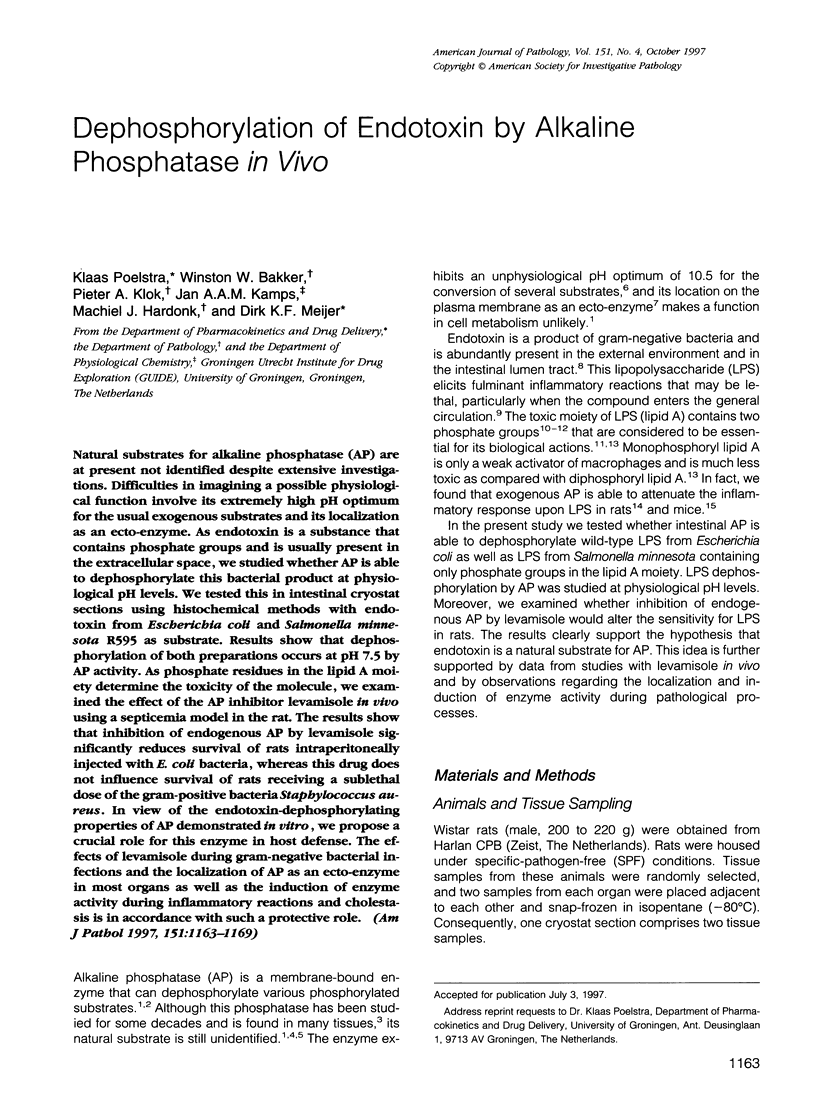
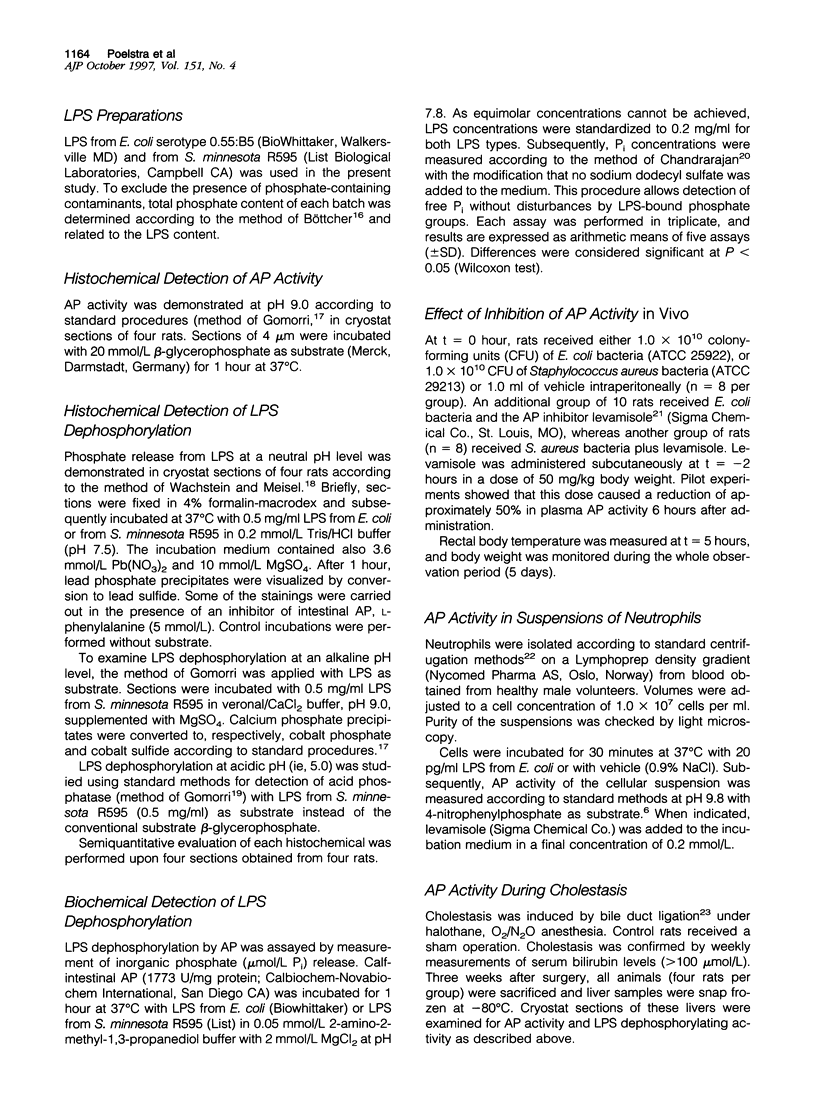
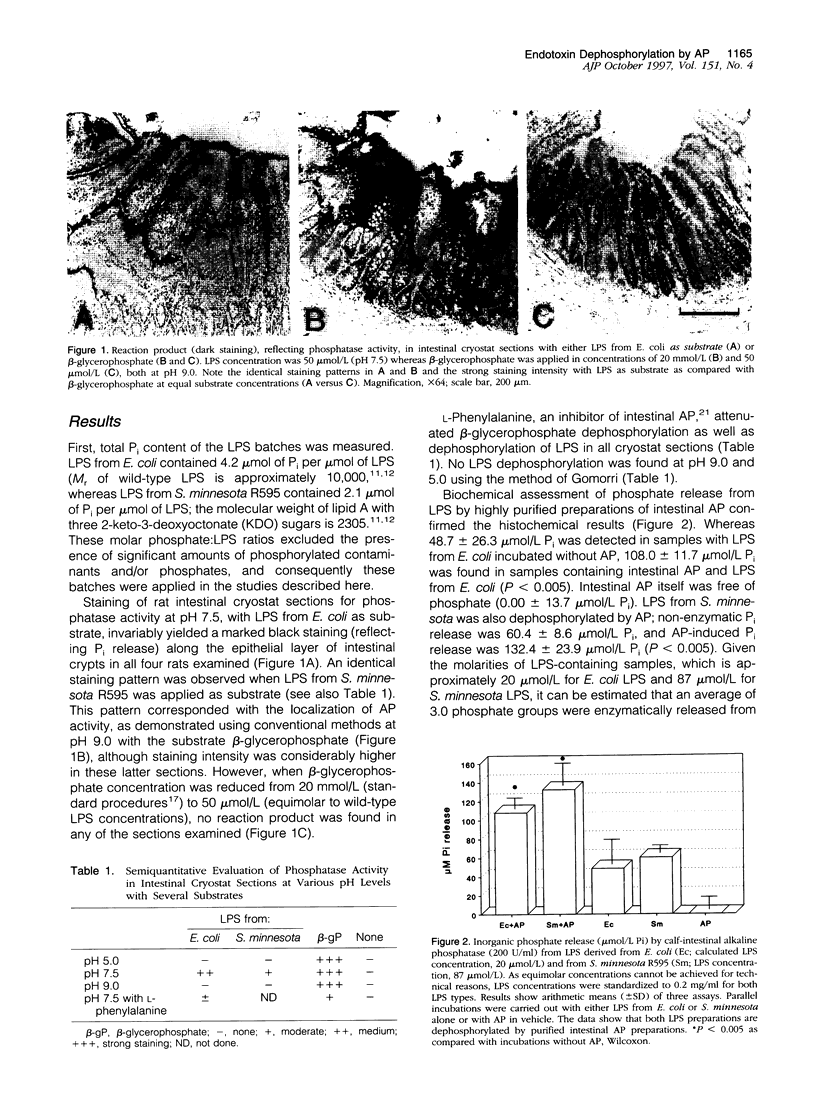
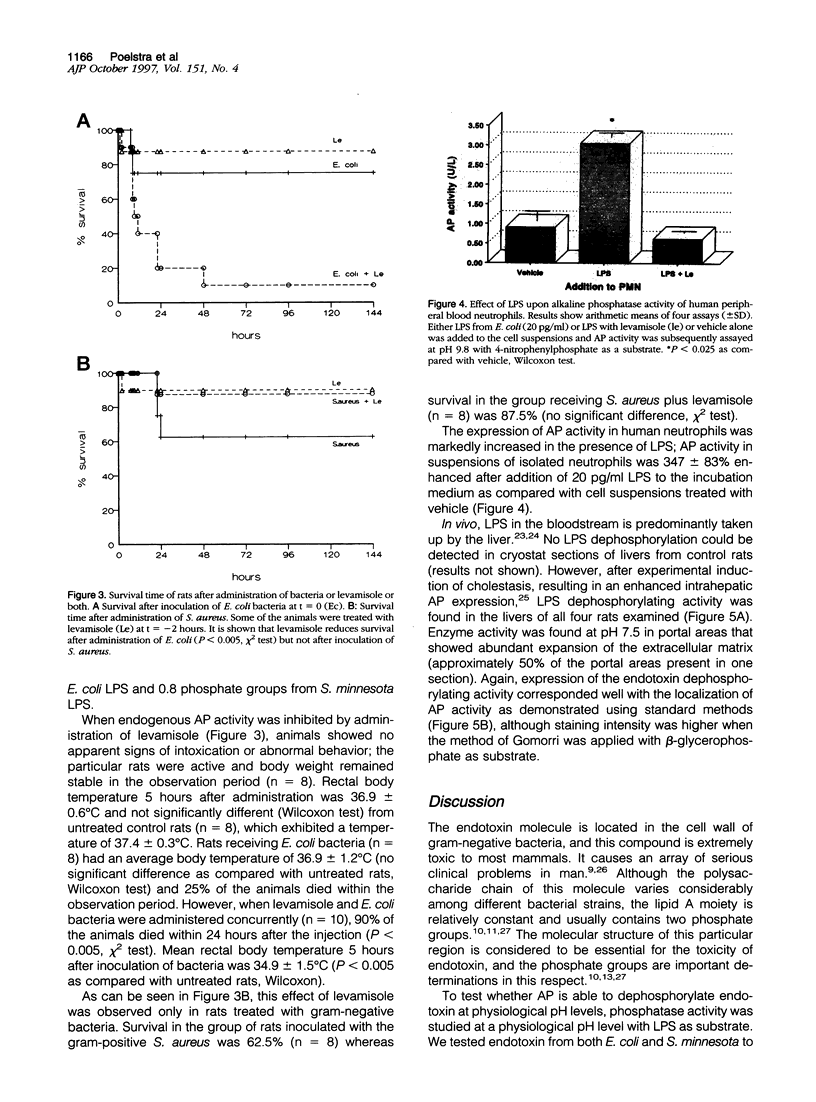
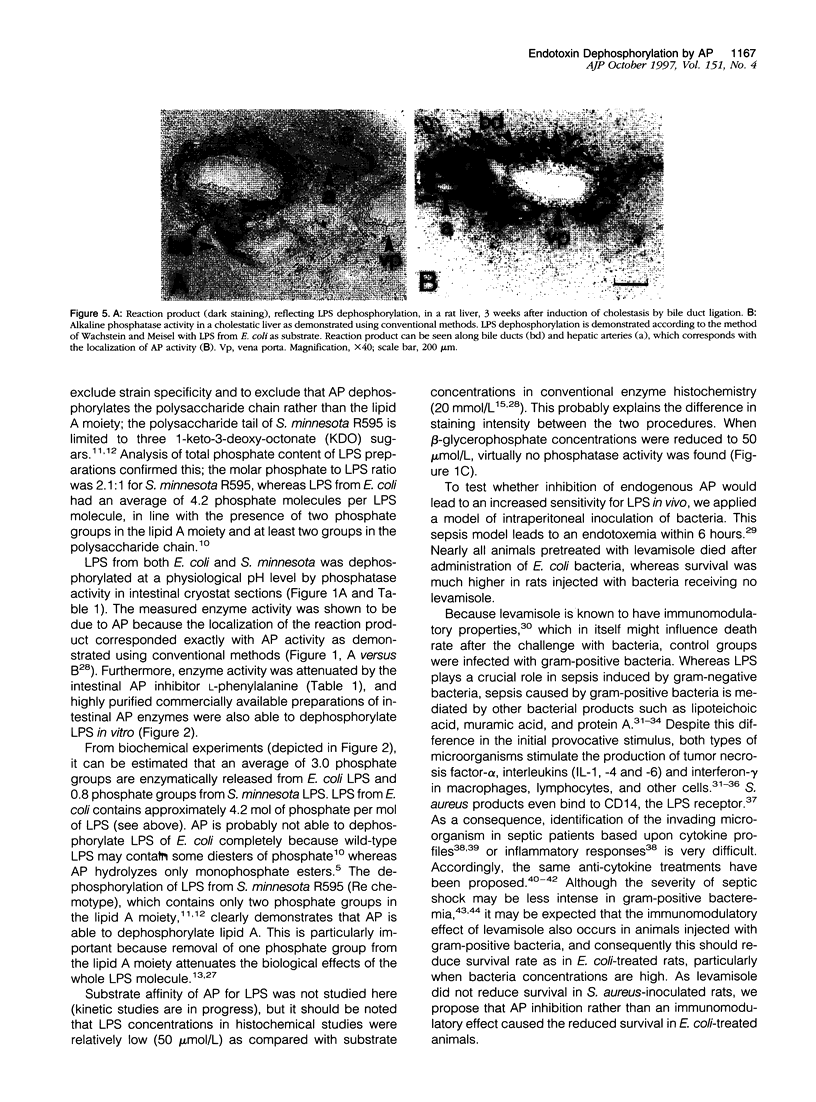
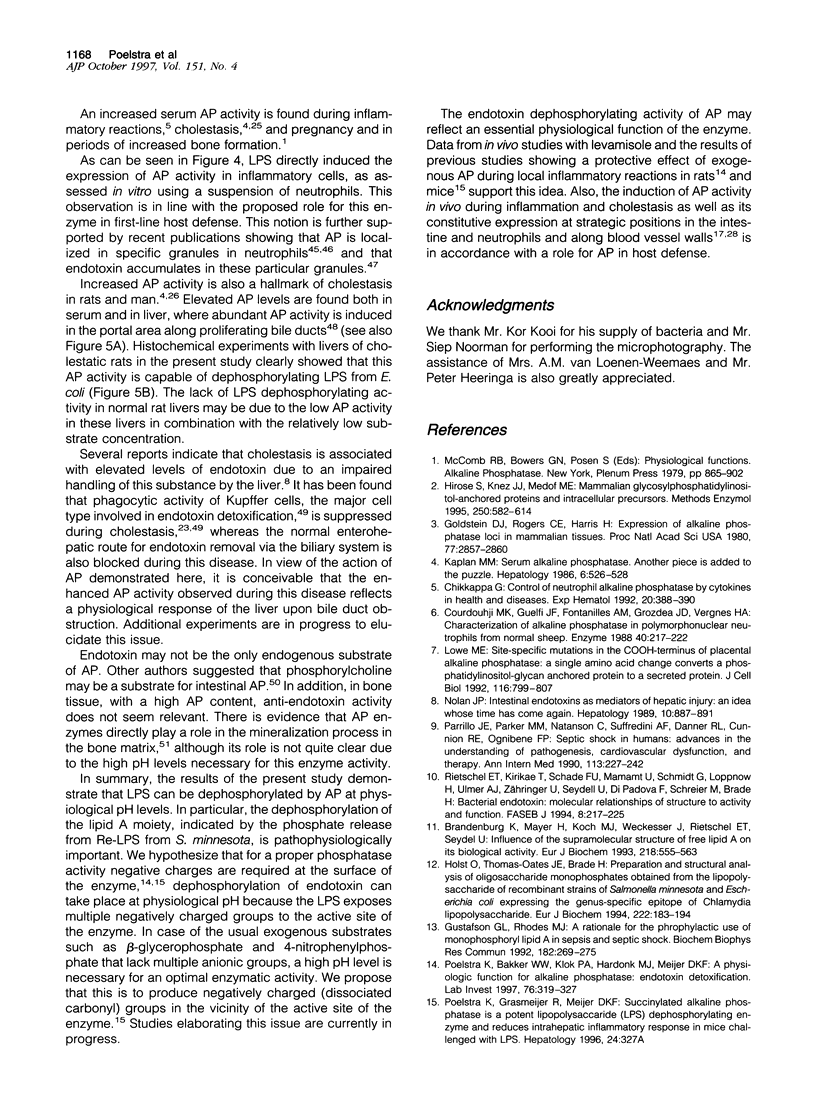
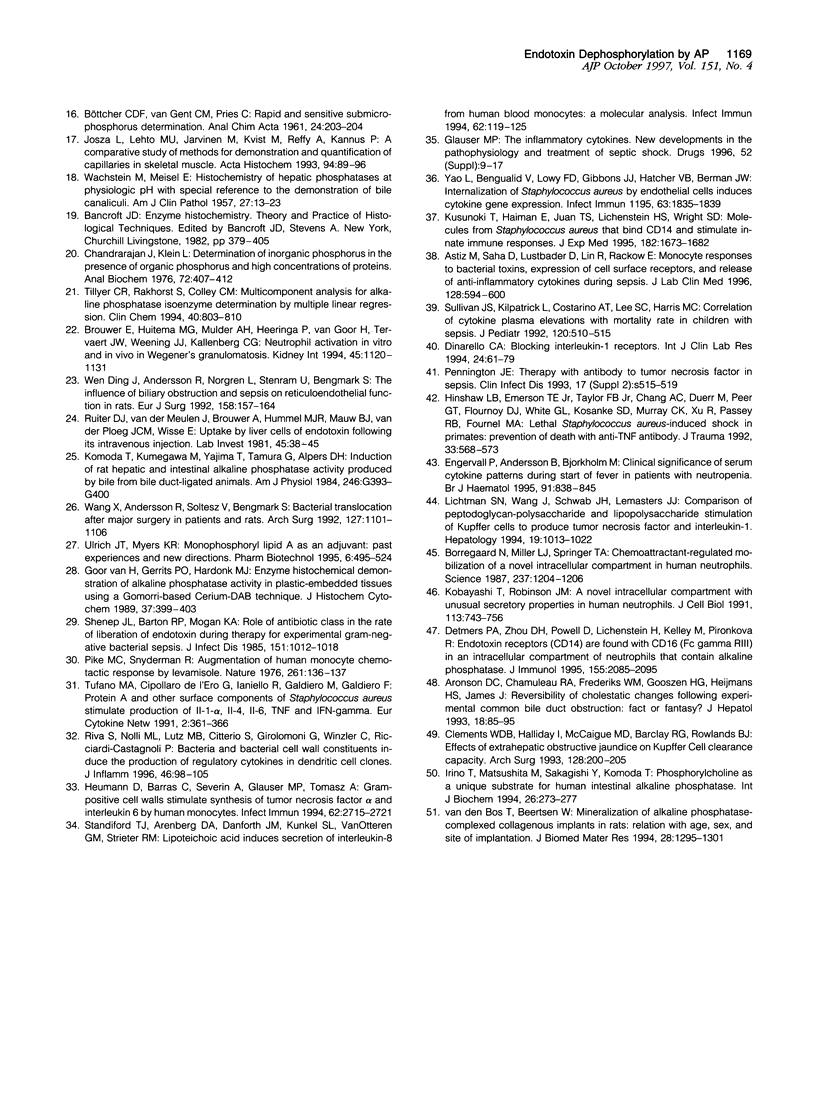
Images in this article
Selected References
These references are in PubMed. This may not be the complete list of references from this article.
- Aronson D. C., Chamuleau R. A., Frederiks W. M., Gooszen H. G., Heijmans H. S., James J. Reversibility of cholestatic changes following experimental common bile duct obstruction: fact or fantasy? J Hepatol. 1993 Apr;18(1):85–95. doi: 10.1016/s0168-8278(05)80014-5. [DOI] [PubMed] [Google Scholar]
- Astiz M., Saha D., Lustbader D., Lin R., Rackow E. Monocyte response to bacterial toxins, expression of cell surface receptors, and release of anti-inflammatory cytokines during sepsis. J Lab Clin Med. 1996 Dec;128(6):594–600. doi: 10.1016/s0022-2143(96)90132-8. [DOI] [PubMed] [Google Scholar]
- Borregaard N., Miller L. J., Springer T. A. Chemoattractant-regulated mobilization of a novel intracellular compartment in human neutrophils. Science. 1987 Sep 4;237(4819):1204–1206. doi: 10.1126/science.3629236. [DOI] [PubMed] [Google Scholar]
- Brandenburg K., Mayer H., Koch M. H., Weckesser J., Rietschel E. T., Seydel U. Influence of the supramolecular structure of free lipid A on its biological activity. Eur J Biochem. 1993 Dec 1;218(2):555–563. doi: 10.1111/j.1432-1033.1993.tb18409.x. [DOI] [PubMed] [Google Scholar]
- Brouwer E., Huitema M. G., Mulder A. H., Heeringa P., van Goor H., Tervaert J. W., Weening J. J., Kallenberg C. G. Neutrophil activation in vitro and in vivo in Wegener's granulomatosis. Kidney Int. 1994 Apr;45(4):1120–1131. doi: 10.1038/ki.1994.149. [DOI] [PubMed] [Google Scholar]
- ChandraRajan J., Klein L. Determination of inorganic phosphorus in the presence of organic phosphorus and high concentrations of proteins. Anal Biochem. 1976 May 7;72:407–412. doi: 10.1016/0003-2697(76)90548-0. [DOI] [PubMed] [Google Scholar]
- Chikkappa G. Control of neutrophil alkaline phosphatase synthesis by cytokines in health and diseases. Exp Hematol. 1992 May;20(4):388–390. [PubMed] [Google Scholar]
- Clements W. D., Halliday M. I., McCaigue M. D., Barclay R. G., Rowlands B. J. Effects of extrahepatic obstructive jaundice on Kupffer cell clearance capacity. Arch Surg. 1993 Feb;128(2):200–205. doi: 10.1001/archsurg.1993.01420140077012. [DOI] [PubMed] [Google Scholar]
- Courdouhji M. K., Guelfi J. F., Fontanilles A. M., Grozdea J. D., Vergnes H. A. Characterization of alkaline phosphatase in polymorphonuclear neutrophils from normal sheep. Enzyme. 1988;40(4):217–222. doi: 10.1159/000469166. [DOI] [PubMed] [Google Scholar]
- Detmers P. A., Zhou D., Powell D., Lichenstein H., Kelley M., Pironkova R. Endotoxin receptors (CD14) are found with CD16 (Fc gamma RIII) in an intracellular compartment of neutrophils that contains alkaline phosphatase. J Immunol. 1995 Aug 15;155(4):2085–2095. [PubMed] [Google Scholar]
- Dinarello C. A. Blocking interleukin-1 receptors. Int J Clin Lab Res. 1994;24(2):61–79. doi: 10.1007/BF02593903. [DOI] [PubMed] [Google Scholar]
- Ding J. W., Andersson R., Norgren L., Stenram U., Bengmark S. The influence of biliary obstruction and sepsis on reticuloendothelial function in rats. Eur J Surg. 1992 Mar;158(3):157–164. [PubMed] [Google Scholar]
- Engervall P., Andersson B., Björkholm M. Clinical significance of serum cytokine patterns during start of fever in patients with neutropenia. Br J Haematol. 1995 Dec;91(4):838–845. doi: 10.1111/j.1365-2141.1995.tb05398.x. [DOI] [PubMed] [Google Scholar]
- Glauser M. P. The inflammatory cytokines. New developments in the pathophysiology and treatment of septic shock. Drugs. 1996;52 (Suppl 2):9–17. doi: 10.2165/00003495-199600522-00004. [DOI] [PubMed] [Google Scholar]
- Goldstein D. J., Rogers C. E., Harris H. Expression of alkaline phosphatase loci in mammalian tissues. Proc Natl Acad Sci U S A. 1980 May;77(5):2857–2860. doi: 10.1073/pnas.77.5.2857. [DOI] [PMC free article] [PubMed] [Google Scholar]
- Gustafson G. L., Rhodes M. J. A rationale for the prophylactic use of monophosphoryl lipid A in sepsis and septic shock. Biochem Biophys Res Commun. 1992 Jan 15;182(1):269–275. doi: 10.1016/s0006-291x(05)80140-8. [DOI] [PubMed] [Google Scholar]
- Heumann D., Barras C., Severin A., Glauser M. P., Tomasz A. Gram-positive cell walls stimulate synthesis of tumor necrosis factor alpha and interleukin-6 by human monocytes. Infect Immun. 1994 Jul;62(7):2715–2721. doi: 10.1128/iai.62.7.2715-2721.1994. [DOI] [PMC free article] [PubMed] [Google Scholar]
- Hinshaw L. B., Emerson T. E., Jr, Taylor F. B., Jr, Chang A. C., Duerr M., Peer G. T., Flournoy D. J., White G. L., Kosanke S. D., Murray C. K. Lethal Staphylococcus aureus-induced shock in primates: prevention of death with anti-TNF antibody. J Trauma. 1992 Oct;33(4):568–573. [PubMed] [Google Scholar]
- Hirose S., Knez J. J., Medof M. E. Mammalian glycosylphosphatidylinositol-anchored proteins and intracellular precursors. Methods Enzymol. 1995;250:582–614. doi: 10.1016/0076-6879(95)50099-5. [DOI] [PubMed] [Google Scholar]
- Holst O., Thomas-Oates J. E., Brade H. Preparation and structural analysis of oligosaccharide monophosphates obtained from the lipopolysaccharide of recombinant strains of Salmonella minnesota and Escherichia coli expressing the genus-specific epitope of Chlamydia lipopolysaccharide. Eur J Biochem. 1994 May 15;222(1):183–194. doi: 10.1111/j.1432-1033.1994.tb18856.x. [DOI] [PubMed] [Google Scholar]
- Irino T., Matsushita M., Sakagishi Y., Komoda T. Phosphorylcholine as a unique substrate for human intestinal alkaline phosphatase. Int J Biochem. 1994 Feb;26(2):273–277. doi: 10.1016/0020-711x(94)90157-0. [DOI] [PubMed] [Google Scholar]
- Jósza L., Lehto M. U., Järvinen M., Kvist M., Réffy A., Kannus P. A comparative study of methods for demonstration and quantification of capillaries in skeletal muscle. Acta Histochem. 1993 Feb;94(1):89–96. doi: 10.1016/S0065-1281(11)80344-2. [DOI] [PubMed] [Google Scholar]
- Kaplan M. M. Serum alkaline phosphatase--another piece is added to the puzzle. Hepatology. 1986 May-Jun;6(3):526–528. doi: 10.1002/hep.1840060334. [DOI] [PubMed] [Google Scholar]
- Kobayashi T., Robinson J. M. A novel intracellular compartment with unusual secretory properties in human neutrophils. J Cell Biol. 1991 May;113(4):743–756. doi: 10.1083/jcb.113.4.743. [DOI] [PMC free article] [PubMed] [Google Scholar]
- Komoda T., Kumegawa M., Yajima T., Tamura G., Alpers D. H. Induction of rat hepatic and intestinal alkaline phosphatase activity produced by bile from bile duct-ligated animals. Am J Physiol. 1984 Apr;246(4 Pt 1):G393–G400. doi: 10.1152/ajpgi.1984.246.4.G393. [DOI] [PubMed] [Google Scholar]
- Kusunoki T., Hailman E., Juan T. S., Lichenstein H. S., Wright S. D. Molecules from Staphylococcus aureus that bind CD14 and stimulate innate immune responses. J Exp Med. 1995 Dec 1;182(6):1673–1682. doi: 10.1084/jem.182.6.1673. [DOI] [PMC free article] [PubMed] [Google Scholar]
- Lichtman S. N., Wang J., Schwab J. H., Lemasters J. J. Comparison of peptidoglycan-polysaccharide and lipopolysaccharide stimulation of Kupffer cells to produce tumor necrosis factor and interleukin-1. Hepatology. 1994 Apr;19(4):1013–1022. [PubMed] [Google Scholar]
- Lowe M. E. Site-specific mutations in the COOH-terminus of placental alkaline phosphatase: a single amino acid change converts a phosphatidylinositol-glycan-anchored protein to a secreted protein. J Cell Biol. 1992 Feb;116(3):799–807. doi: 10.1083/jcb.116.3.799. [DOI] [PMC free article] [PubMed] [Google Scholar]
- Nolan J. P. Intestinal endotoxins as mediators of hepatic injury--an idea whose time has come again. Hepatology. 1989 Nov;10(5):887–891. doi: 10.1002/hep.1840100523. [DOI] [PubMed] [Google Scholar]
- Parrillo J. E., Parker M. M., Natanson C., Suffredini A. F., Danner R. L., Cunnion R. E., Ognibene F. P. Septic shock in humans. Advances in the understanding of pathogenesis, cardiovascular dysfunction, and therapy. Ann Intern Med. 1990 Aug 1;113(3):227–242. doi: 10.7326/0003-4819-113-3-227. [DOI] [PubMed] [Google Scholar]
- Pennington J. E. Therapy with antibody to tumor necrosis factor in sepsis. Clin Infect Dis. 1993 Nov;17 (Suppl 2):S515–S519. doi: 10.1093/clinids/17.supplement_2.s515. [DOI] [PubMed] [Google Scholar]
- Pike M. C., Snyderman R. Augmentation of human monocyte chemotactic response by levamisole. Nature. 1976 May 13;261(5556):136–137. doi: 10.1038/261136a0. [DOI] [PubMed] [Google Scholar]
- Poelstra K., Bakker W. W., Klok P. A., Hardonk M. J., Meijer D. K. A physiologic function for alkaline phosphatase: endotoxin detoxification. Lab Invest. 1997 Mar;76(3):319–327. [PubMed] [Google Scholar]
- Rietschel E. T., Kirikae T., Schade F. U., Mamat U., Schmidt G., Loppnow H., Ulmer A. J., Zähringer U., Seydel U., Di Padova F. Bacterial endotoxin: molecular relationships of structure to activity and function. FASEB J. 1994 Feb;8(2):217–225. doi: 10.1096/fasebj.8.2.8119492. [DOI] [PubMed] [Google Scholar]
- Riva S., Nolli M. L., Lutz M. B., Citterio S., Girolomoni G., Winzler C., Ricciardi-Castagnoli P. Bacteria and bacterial cell wall constituents induce the production of regulatory cytokines in dendritic cell clones. J Inflamm. 1996;46(2):98–105. [PubMed] [Google Scholar]
- Ruiter D. J., van der Meulen J., Brouwer A., Hummel M. J., Mauw B. J., van der Ploeg J. C., Wisse E. Uptake by liver cells of endotoxin following its intravenous injection. Lab Invest. 1981 Jul;45(1):38–45. [PubMed] [Google Scholar]
- Shenep J. L., Barton R. P., Mogan K. A. Role of antibiotic class in the rate of liberation of endotoxin during therapy for experimental gram-negative bacterial sepsis. J Infect Dis. 1985 Jun;151(6):1012–1018. doi: 10.1093/infdis/151.6.1012. [DOI] [PubMed] [Google Scholar]
- Standiford T. J., Arenberg D. A., Danforth J. M., Kunkel S. L., VanOtteren G. M., Strieter R. M. Lipoteichoic acid induces secretion of interleukin-8 from human blood monocytes: a cellular and molecular analysis. Infect Immun. 1994 Jan;62(1):119–125. doi: 10.1128/iai.62.1.119-125.1994. [DOI] [PMC free article] [PubMed] [Google Scholar]
- Sullivan J. S., Kilpatrick L., Costarino A. T., Jr, Lee S. C., Harris M. C. Correlation of plasma cytokine elevations with mortality rate in children with sepsis. J Pediatr. 1992 Apr;120(4 Pt 1):510–515. doi: 10.1016/s0022-3476(05)82476-x. [DOI] [PubMed] [Google Scholar]
- Tillyer C. R., Rakhorst S., Colley C. M. Multicomponent analysis for alkaline phosphatase isoenzyme determination by multiple linear regression. Clin Chem. 1994 May;40(5):803–810. [PubMed] [Google Scholar]
- Tufano M. A., Cipollaro de l'Ero G., Ianniello R., Galdiero M., Galdiero F. Protein A and other surface components of Staphylococcus aureus stimulate production of IL-1 alpha, IL-4, IL-6, TNF and IFN-gamma. Eur Cytokine Netw. 1991 Nov-Dec;2(5):361–366. [PubMed] [Google Scholar]
- Ulrich J. T., Myers K. R. Monophosphoryl lipid A as an adjuvant. Past experiences and new directions. Pharm Biotechnol. 1995;6:495–524. [PubMed] [Google Scholar]
- WACHSTEIN M., MEISEL E. Histochemistry of hepatic phosphatases of a physiologic pH; with special reference to the demonstration of bile canaliculi. Am J Clin Pathol. 1957 Jan;27(1):13–23. doi: 10.1093/ajcp/27.1.13. [DOI] [PubMed] [Google Scholar]
- Wang X., Andersson R., Soltesz V., Bengmark S. Bacterial translocation after major hepatectomy in patients and rats. Arch Surg. 1992 Sep;127(9):1101–1106. doi: 10.1001/archsurg.1992.01420090109016. [DOI] [PubMed] [Google Scholar]
- Yao L., Bengualid V., Lowy F. D., Gibbons J. J., Hatcher V. B., Berman J. W. Internalization of Staphylococcus aureus by endothelial cells induces cytokine gene expression. Infect Immun. 1995 May;63(5):1835–1839. doi: 10.1128/iai.63.5.1835-1839.1995. [DOI] [PMC free article] [PubMed] [Google Scholar]
- van Goor H., Gerrits P. O., Hardonk M. J. Enzyme histochemical demonstration of alkaline phosphatase activity in plastic-embedded tissues using a Gomori-based cerium-DAB technique. J Histochem Cytochem. 1989 Mar;37(3):399–403. doi: 10.1177/37.3.2465338. [DOI] [PubMed] [Google Scholar]
- van den Bos T., Beertsen W. Mineralization of alkaline phosphatase-complexed collagenous implants in the rat: relation with age, sex, and site of implantation. J Biomed Mater Res. 1994 Nov;28(11):1295–1301. doi: 10.1002/jbm.820281107. [DOI] [PubMed] [Google Scholar]




